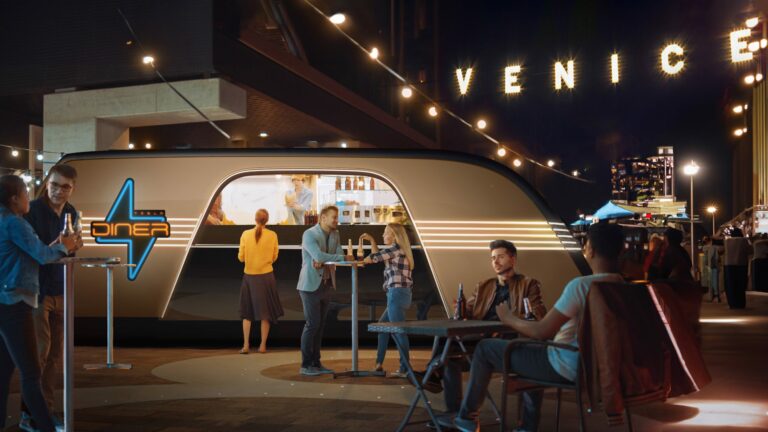Tesla’s Robovan: Redefining Urban Mobility
Tesla has once again captured the public’s attention with the unveiling of its latest project: the Tesla Robovan. Introduced at the 2024 ‘We, Robot’ event, this innovative vehicle is designed to function as both a passenger carrier and a cargo transporter, operating entirely autonomously. The Robovan, much like the recently unveiled Cybercab, aims to reshape the way we think about urban transit, providing solutions for various sectors including logistics, public transport, and mobility as a service.

Versatility at its Core
The Tesla Robovan isn’t merely a larger version of Tesla’s existing vehicle lineup; it represents a new concept entirely. During the unveiling, Elon Musk described the Robovan as “a Swiss army knife of transportation,” emphasizing its flexibility for both passenger and cargo purposes. Whether it’s transporting commuters or delivering packages, the Robovan is engineered to fulfill a multitude of roles. Key to its adaptability is its all-electric powertrain, combined with Tesla’s latest Full Self-Driving (FSD) hardware. Musk highlighted the vehicle’s inherent adaptability, stating, “This is more than just a van; it’s a platform for the future of transportation. The Robovan can autonomously handle the movement of both goods and people.”

Key Features
Tesla has equipped the Robovan with features aimed at maximizing efficiency, comfort, and usability within urban environments.
- Seating Capacity: The Robovan can accommodate up to 20 passengers, making it suitable for public transportation, rideshare services, and shuttle fleets. The absence of a driver allows for a more spacious cabin, optimizing seating arrangements and enhancing legroom.
- Cargo Flexibility: For logistics purposes, seats can be reconfigured or removed entirely to create ample space for transporting goods. This flexibility positions the Robovan as a strong contender for last-mile delivery services.
- Advanced Suspension System: A standout feature of the Robovan is its innovative suspension system, which is engineered to provide optimal comfort whether carrying passengers or heavy cargo. Elon Musk mentioned in a post-event interview that “We engineered the Robovan’s suspension to adapt in real time based on load, providing a smoother ride for passengers and stability for cargo.”
- Full-Self Driving Technology: Similar to the Tesla Cybercab, the Robovan will incorporate Tesla’s latest FSD software. This system uses advanced sensors and AI to navigate urban areas, managing everything from busy city streets to complex intersections.

Addressing Congestion and Pollution
Urban centers worldwide are facing growing challenges related to traffic congestion and environmental pollution. The Tesla Robovan is designed to tackle both of these issues head-on. The vehicle’s electric powertrain eliminates tailpipe emissions, contributing to cleaner air. Its autonomous driving system can help reduce traffic by optimizing routes and minimizing human error. The Robovan offers a potential boost to public transportation systems. With its 20-seat capacity and autonomous operation, the Robovan could serve as a more efficient alternative to traditional buses.
Affordability and Accessibility
Tesla has aimed to position the Robovan as an affordable solution for private companies and public entities alike. While official pricing is yet to be confirmed, preliminary estimates suggest the Robovan will start at around $50,000, making it competitive with other electric vans and buses. Tesla’s focus on large-scale adoption indicates potential partnerships with municipalities, delivery services, and ride-sharing platforms to deploy substantial Robovan fleets in major cities. This affordability could open up new avenues for autonomous vehicles. According to Musk, “We’re not just building vehicles for wealthy consumers. The Robovan is part of a bigger vision to make transportation more affordable, efficient, and accessible for everyone.”
Autonomous Safety
Safety is paramount with any autonomous vehicle. Tesla has previously faced scrutiny regarding its FSD software, but Musk expressed confidence that the Robovan will surpass expectations. During the We Robot event, he remarked, “The Robovan’s safety systems are second to none. It’s equipped with the latest AI and neural network technology, ensuring that it not only follows traffic laws but reacts faster than any human driver could.” Tesla’s Full-Self Driving technology is continuously updated, improving its performance using real-time data, and the Robovan will benefit from these continuous updates.
Potential Applications
Tesla envisions the Robovan serving various functions in urban environments, including:
- Public Transit: Its 20-seat capacity makes it suitable for public shuttle services or replacing traditional buses on shorter routes.
- Ride-Hailing and Rideshare: Similar to the Cybercab, the Robovan could operate in rideshare fleets, offering autonomous transport for larger groups.
- Last-Mile Delivery: With its cargo-hauling capabilities, the Robovan could revolutionize last-mile logistics.
- Corporate and Campus Transport: Businesses and universities could deploy Robovan fleets for employee or student shuttles, reducing emissions and operational costs.
Challenges Ahead
While the Robovan presents exciting possibilities, its success depends on several factors. Regulatory approval for autonomous vehicles remains a significant hurdle, particularly in regions with stringent safety regulations. The Robovan will also face competition from other electric and autonomous vehicles, including those from companies such as Rivian, GM, and Waymo. Additionally, public acceptance of fully autonomous transportation is a concern, and overcoming skepticism regarding safety and reliability will be crucial for broader adoption.
In conclusion, Tesla’s Robovan has the potential to transform urban transportation. Its flexible design, advanced technology, and focus on passenger and cargo transport position it to become a staple of modern cities. If Tesla can successfully navigate the regulatory landscape and build public trust, the Robovan could reshape how we move people and goods through congested urban environments.



